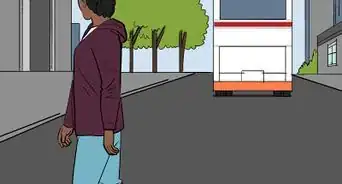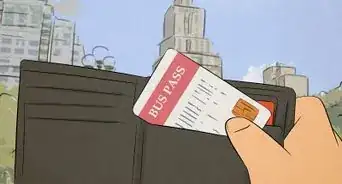X
wikiHow is a “wiki,” similar to Wikipedia, which means that many of our articles are co-written by multiple authors. To create this article, volunteer authors worked to edit and improve it over time.
Learn more...
Around 26 million children in the U.S. take the school bus to and from school each day. [1] In total, there are more than 480,000 large yellow buses driving kids to and from school every day. Many kids take the school bus every day to and from school, whereas some kids only take it during field trips and other events. While you're on the bus, it is important to follow some important safety procedures to avoid getting injured or hurt. Here are some important tips to know when going on a school bus.
Steps
Part 1
Part 1 of 3:
Getting On and Off the Bus
-
1Stay far away from the bus if you're getting on the bus. School buses are huge vehicles, and they can pose a threat when they move. If you stay 10-12 feet next to, in front of, or behind the bus, the driver may not see you and move their bus towards you, which can kill you. So, stay away from the bus on the curb or on a platform near the bus to stay safe.
-
2Form a single file line to get on or off the bus. Two or more people shouldn't try to get on or off the bus at once, as the bus's entrance is pretty narrow. The people could get injured if they push and pull each other to get on the bus. Wait in a straight line, with each student in front of another to get on. Don't push people aside and rush to get in; it's best to wait your turn instead of being impatient and potentially injuring others.Advertisement
-
3Wait until the bus has completely stopped before getting on or off. Getting on or off of a moving bus is very dangerous, and it could lead to serious injuries or death. If the bus is still slowly moving or parking, stay in your seat if you are exiting and don't rush to the exit. If you are entering the bus, stay on the curb and don't go on the road or near the bus, as it could hit you. [2] No matter how excited you are to get on or off the bus for the 1st day of a field trip, don't stand up and walk until the bus has stopped moving.
- Sit in your seat and stand up only if the bus has stopped moving or is near a stand-still to exit safely.
-
4Use the handrails to guide yourself into the bus. The stairs may be a bit steep, so you are more likely to trip and fall. Grip the handrails while stepping step by step into or out of the bus. [3] Don't skip steps or jump up the steps either, as you could trip and bump into things on the bus.
- Walk slowly and carefully into the bus and find a seat. You may prefer sitting with your friends. If you're younger, you may prefer sitting with a parent or chaperone to feel safer.
Advertisement
Part 2
Part 2 of 3:
Staying Safe in the Bus
-
1Stay seated the whole time of the bus trip. Once you've chosen a seat and sat down, stay seated for the whole duration that the bus is moving. Walking around on a moving bus or even standing still in your seat is dangerous, especially if the bus is moving fast. If the bus bumps into something, inertia will pull you back and make you trip or bump into something.
- If the bus was moving fast, the inertia will be larger, making your hit really hard and forceful. This would cause serious injuries.
- If the bus is shifting bit by bit to park, it's still best to remain seated.
-
2Don't distract the driver. The driver needs to stay completely alert and concentrated to drive safely. If you distract the driver, they could accidentally drive the bus and bump into things, or they could drive too fast or too slow, which would be dangerous for all of the people on the bus (students, parents, chaperones, the driver).
- So, don't try to play pranks or strike up a conversation with the driver.
-
3Buckle up your seatbelt if your bus has seatbelts. Most states in the U.S. don't require seatbelts on school buses, although states like California, Florida, and New Jersey require them. [4] Some buses may only have lap seatbelts or shoulder seatbelts, whereas some may have a combination of both of them. For your safety, it's best to buckle your seatbelt to keep you strapped in and to prevent you from being pushed or pulled forward and back because of inertia (if the bus has made a sudden stop).
-
4Sit with 1-2 additional people at most. If you have five friends, don't try to squish you and four other people onto one seat! If the bus makes a turn or stops abruptly, someone could fall off the seat, which is a safety hazard. To prevent this, sit with two other people at maximum if you're middle-school-aged or older. If you're an especially small kid for your age or if you're a very young child, the seat may fit 3-4 kids. [5]
Advertisement
Part 3
Part 3 of 3:
School Bus Etiquette
-
1Keep your volume down on the bus. This means that you shouldn't talk loudly, yell, scream, or laugh loudly in the bus. Of course, you should still enjoy yourself during a bus trip. But you shouldn't be very loud, as the driver and other students may find it disruptive.
-
2Talk with the person/people sitting beside you. It's best to not shout across the whole bus to talk to your classmates sitting four rows behind you, since that would also be disruptive. Try to be quiet, and talk quietly to the people beside you. Find things to talk about, such as popular culture, the news, school, and homework. If you're riding the bus for a field trip, talk about what you're looking forward to for the trip.
-
3Find things to do on the bus. If your commute is 20 minutes or longer, you may need to find things to do to spend your time without getting bored. Your school might be further away, or maybe you are going on a field trip with your classmates. Without disrupting your classmates, teachers, chaperones, and anyone else on the bus, here are some things to do on the bus.
- Look out the window for some scenery. Depending on the route your bus takes, you may see some neighborhoods and a few streets. For schools further away, you may see a highway and a ton of cars driving past. If you're going on a field trip, you may see interesting sights such as famous buildings, roads, highways, and natural scenery.
- Play "I Spy" with a friend sitting next to you on the bus. Find something you see out the window, and describe it without directly telling your friend what it is.
- Create a story. Start off the story by saying one sentence, then having you or your friend continue it by saying another sentence (it has to logically flow).
- Listen to music. This usually works for commutes to and from school or long field trips (overnight or more), where you're allowed to bring earbuds and other personal belongings. You may not be allowed to bring anything with you if the field trip's less than a day long.
Advertisement
References
- ↑ https://www.nysbca.com/fastfacts#:~:text=Yellow%20School%20Bus%20Facts,and%20from%20school%20each%20day.
- ↑ https://www.nhtsa.gov/road-safety/school-bus-safety
- ↑ https://www.safekids.org/safetytips/field_risks/school-bus-safety
- ↑ https://www.truckaccidentattorneynetwork.org/which-states-require-seatbelts-on-school-buses/
- ↑ https://nasdpts.org/resources/Documents/Paper-SeatingCapacity.pdf
About This Article
Advertisement



























































